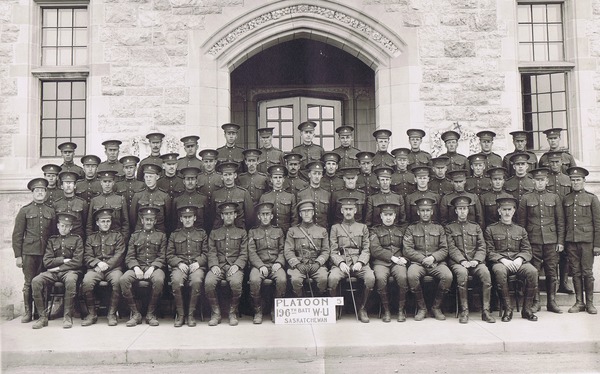Search Great War Images from the U of S
196th Western University Battalion
 The Great War exacted a heavy toll on the University of Saskatchewan. Of the 345 students, faculty and staff who enlisted, 69 "passed out of the sight of man by the path of duty and self-sacrifice." Almost 100 were wounded, and 35 were awarded medals of valour. The School of Engineering closed its doors for the1916-1917 session when the faculty and students enlisted en masse. In early 1916 the idea of a Western University Battalion took root. Initially the Canadian military was reluctant, but the combination of a strong lobbying campaign and the need for fresh troops to replace the mounting casualties in Europe tipped the scales. Reginald Bateman, the university’s first Professor of English and war hero, was sent back to Canada to raise a company of the 196th (Western Universities) Battalion. President Murray was to play a dominant role in the formation of the “Western Universities Battalion” and almost single-handedly recruited the “Saskatchewan Company” for the Battalion. The 196th was to consist of a company from each of the four western provinces. Once formed, it trained at Camp Hughes in Manitoba and was then sent to England. The 196th’s history was brief. Once in England it was broken up to reinforce existing units. A high portion of the recruits eventually found themselves in the officers’ ranks. Many found themselves assigned to the Saskatchewan-dominated 46th Battalion. Also known as the "Suicide Battalion," it fought in some of the bloodiest encounters of the war. Reinforcements were constantly needed as battle after battle decimated its ranks. Of the 5,374 men in the 46th Battalion, 4,917 were either killed or wounded. With the end of the war came demobilization and the end of the 46th Battalion. The soldiers became veterans and returned to civilian life. Many re-enrolled or entered the university for the first time. Reginald Bateman did not return. He was killed in France on 3 September 1918.
The Great War exacted a heavy toll on the University of Saskatchewan. Of the 345 students, faculty and staff who enlisted, 69 "passed out of the sight of man by the path of duty and self-sacrifice." Almost 100 were wounded, and 35 were awarded medals of valour. The School of Engineering closed its doors for the1916-1917 session when the faculty and students enlisted en masse. In early 1916 the idea of a Western University Battalion took root. Initially the Canadian military was reluctant, but the combination of a strong lobbying campaign and the need for fresh troops to replace the mounting casualties in Europe tipped the scales. Reginald Bateman, the university’s first Professor of English and war hero, was sent back to Canada to raise a company of the 196th (Western Universities) Battalion. President Murray was to play a dominant role in the formation of the “Western Universities Battalion” and almost single-handedly recruited the “Saskatchewan Company” for the Battalion. The 196th was to consist of a company from each of the four western provinces. Once formed, it trained at Camp Hughes in Manitoba and was then sent to England. The 196th’s history was brief. Once in England it was broken up to reinforce existing units. A high portion of the recruits eventually found themselves in the officers’ ranks. Many found themselves assigned to the Saskatchewan-dominated 46th Battalion. Also known as the "Suicide Battalion," it fought in some of the bloodiest encounters of the war. Reinforcements were constantly needed as battle after battle decimated its ranks. Of the 5,374 men in the 46th Battalion, 4,917 were either killed or wounded. With the end of the war came demobilization and the end of the 46th Battalion. The soldiers became veterans and returned to civilian life. Many re-enrolled or entered the university for the first time. Reginald Bateman did not return. He was killed in France on 3 September 1918.
Material in this section is scanned from President's Papers 2001,1 B73 and B 124, J.E. Murray fonds MG 61, B. Silversides fonds MG 289 and the University at War Collection MG 328. There are also images from the University Archives Photograph Collection.

